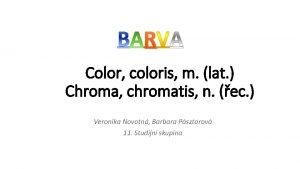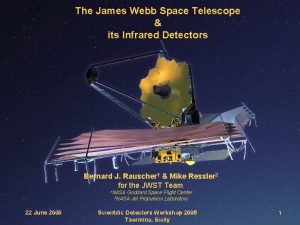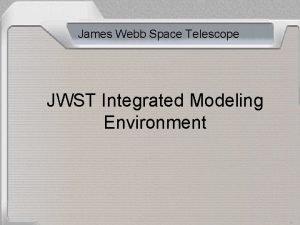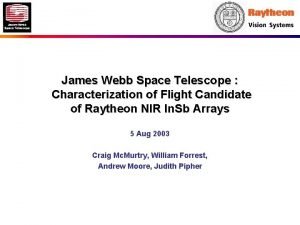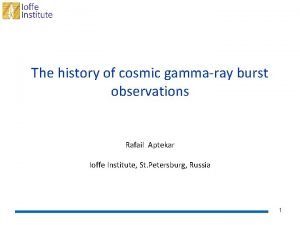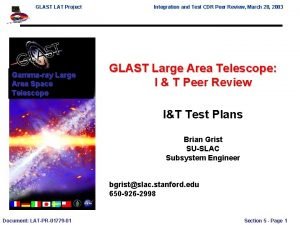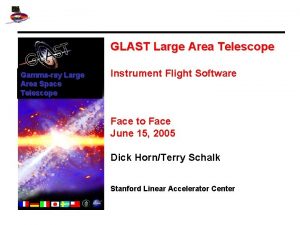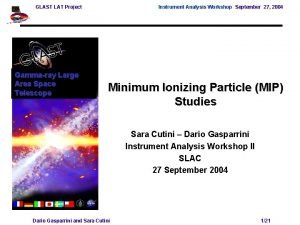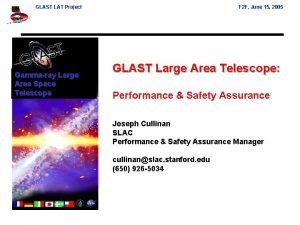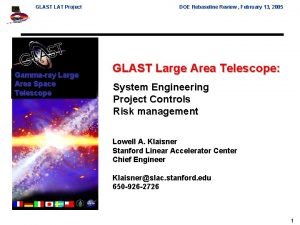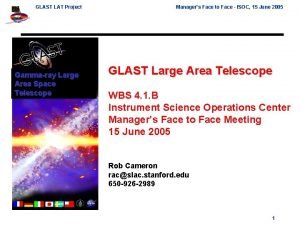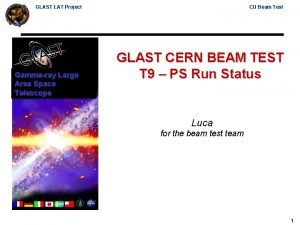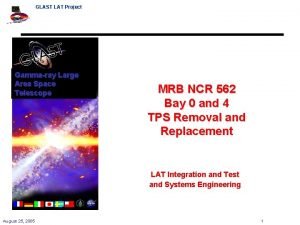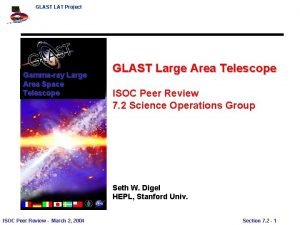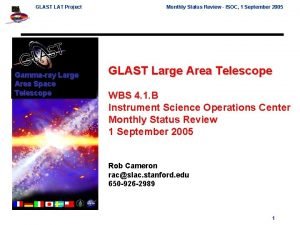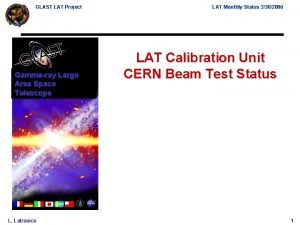GLAST LAT Project Gammaray Large Area Space Telescope










- Slides: 10

GLAST LAT Project Gamma-ray Large Area Space Telescope DOE/NASA Mechanical Systems Peer Review, March 27, 2003 GLAST Large Area Telescope: Mechanical Systems Peer Review 27 March 2003 Section 4. 4 Heat Pipe Thermal Design Aaron Avallon Heat Pipe Product Center Design Engineer aaron. r. avallon@lmco. com Section 4. 4 Heat Pipe Design and Analysis 1

GLAST LAT Project DOE/NASA Mechanical Systems Peer Review, March 27, 2003 Heat Pipe Performance Requirements Based on: Results of Overall LAT Thermal Math Model Verification Methods A: Analysis T: Test Margin is determined by: EP/Req Must be > 1. 3 Section 4. 4 Heat Pipe Design and Analysis 2

GLAST LAT Project DOE/NASA Mechanical Systems Peer Review, March 27, 2003 Heat Pipe Sizing (1 of 2) • All worst case pipe requirements derived from detailed thermal model hot case with the following assumptions and results – Top Flange • 1 of 5 pipes failed • Cumulative heat load and transport requirement calculated directly from Heat Flux (W/m) vs Length Along Pipe (mm) graph • Results in a 9. 2 W-m requirement for each pipe – Downspout • 1 of 6 pipes failed • Maximum environmental load on one radiator panel • Maximum dissipation from the grid of 252 W • All grid heat load must be transported to one radiator • Resulting power requirement for each pipe is 40 W Section 4. 4 Heat Pipe Design and Analysis 3

GLAST LAT Project DOE/NASA Mechanical Systems Peer Review, March 27, 2003 Heat Pipe Sizing (2 of 2) – X-LAT • 1 of 6 pipes failed • Cumulative heat load and transport requirement calculated directly from Heat Flux (W/m) vs Length Along Pipe (mm) graph • Results in a 59. 5 W-m requirement for each pipe – VCHP • 1 of 6 pipes failed • Maximum environmental load on one radiator panel Maximum dissipation from the LAT of 612 W to be dissipated into one radiator panel • Resulting power requirement for each pipe is 94 W Section 4. 4 Heat Pipe Design and Analysis 4

GLAST LAT Project DOE/NASA Mechanical Systems Peer Review, March 27, 2003 Heat Pipe Qual/Acceptance Tests (1 of 2) • Qualification Tests – Extrusion charge optimization (VCHP only, new extrusion) – Burst: 4 * MEOP (Maximum Expected Operating Pressure) • Constant Conductance Heat Pipe Acceptance Tests – Leak: Ammonia leak < 1 x 10 -7 scc/sec – Proof Pressure: Greater of 1. 1 * MPP (Maximum Processing Pressure) or 1. 5 * MEOP – Non-Condensable Gas: Verify acceptable level – Transport: Capability > 1. 3 times requirement – Ammonia Charge: Mass recorded before and after charging Section 4. 4 Heat Pipe Design and Analysis 5

GLAST LAT Project DOE/NASA Mechanical Systems Peer Review, March 27, 2003 Heat Pipe Qual/Acceptance Tests (2 of 2) • Variable Conductance Heat Pipe Acceptance Tests – Leak: Ammonia leak < 1 x 10 -7 scc/sec – Proof Pressure: Greater of 1. 1 * MPP (Maximum Processing Pressure) or 1. 5 * MEOP – Transport: Capability > 1. 3 times requirement – Control Gas (He/Ne) Charge Quantity: Verify correct quantity – Ammonia Charge: Mass recorded before and after charging – Wicking: Tested to insure sufficient wicking (In process test) – Control Performance: Deferred to radiator assy level Section 4. 4 Heat Pipe Design and Analysis 6

GLAST LAT Project DOE/NASA Mechanical Systems Peer Review, March 27, 2003 Heat Pipe Structural Analysis (1 of 2) • • • Top Flange and Downspout Heat Pipes external loads insignificant relative to internal loads due to mounting configuration – Structural integrity demonstrated by heat pipe Qual. /Acceptance tests X-LAT Heat Pipe covered in X-LAT Plate structural analysis presentation VC Heat Pipe covered in Radiator Assembly structural analysis presentation, preliminary analysis covering reservoir and transition complete with the following assumptions and results: – MEOP of 377 PSI (140ºF)**(requirements changed to 490 PSI) – MPP of 882 PSI (210 ºF) – Acceleration loads of 35 G’s replace external flight loads Section 4. 4 Heat Pipe Design and Analysis 7

GLAST LAT Project DOE/NASA Mechanical Systems Peer Review, March 27, 2003 Heat Pipe Structural Analysis (2 of 2) Location Loading Condition Yield Ultimate FOS M. S. Reservoir – Inertia Weld MEOP 1. 5 3. 5 4. 0 1. 0 Reservoir – Inertia Weld MPP 1. 1 1. 6 1. 25 1. 7 Transition Tube – Orbital Weld MEOP 1. 5 6. 7 4. 0 6. 2 Transition Tube – Orbital Weld MPP 1. 1 3. 8 1. 25 9. 5 Transition Tube – Inertia Weld MEOP 1. 5 7. 0 4. 0 6. 5 Transition Tube – Inertia Weld MPP 1. 1 3. 7 1. 25 9. 3 Transition Tube – Inertia Weld MEOP + Acceleration 1. 6 3. 6 2. 0 8. 2 MEOP: Maximum Expected Operating Pressure MPP: Maximum Processing Pressure Section 4. 4 Heat Pipe Design and Analysis 8

GLAST LAT Project DOE/NASA Mechanical Systems Peer Review, March 27, 2003 VCHP Reservoir & Radiator Sizing • Reservoir Sizing: – – Hot case effective sink temperature = 233 K Cold case effective sink temperature = 193 K Computed storage volume ratio = 1. 1 (-10ºC to +15ºC) Required reservoir volume = 75 cc Section 4. 4 Heat Pipe Design and Analysis 9

GLAST LAT Project DOE/NASA Mechanical Systems Peer Review, March 27, 2003 Document Status Document Title Document # % Complete Release Status Top Flange Assy 2 A 15703 95 In Review Downspout Assy 2 A 15705 95 In Review X-LAT Assy 2 A 15704 95 In Review VCHP Assy 2 A 15706 95 In Review Reservoir Assy 2 A 15722 95 In Review Wick Assy 2 A 15723 95 In Review Top Flange Spec 2 A 15699 95 In Review Downspout Spec 2 A 15701 95 In Review X-LAT Spec 2 A 15700 95 In Review VCHP Spec 2 A 15702 25 Draft Top Flange ATP 2 A 15707 60 Draft Downspout ATP 2 A 15709 60 Draft X-LAT ATP 2 A 15708 60 Draft VCHP ATP 2 A 15710 50 Draft Section 4. 4 Heat Pipe Design and Analysis 10

